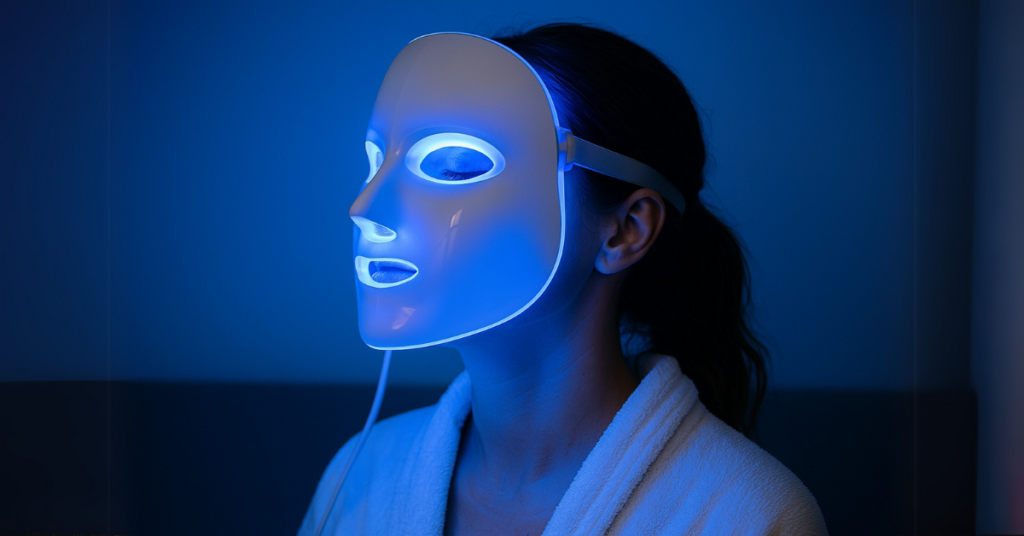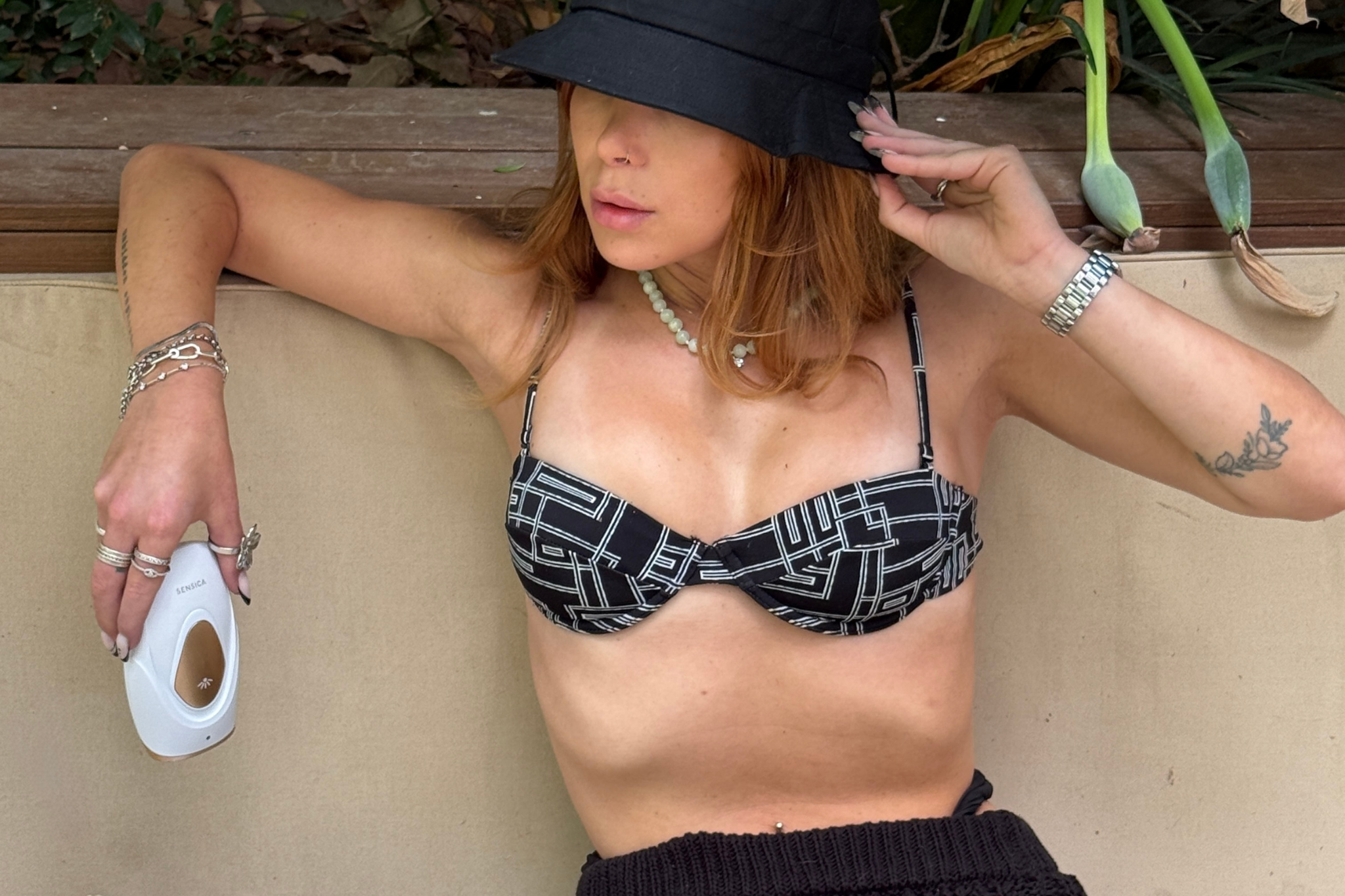From TikTok trends to dermatologist-backed devices, LED light therapy has become the buzzword in acne treatment—and blue light, in particular, is having its moment. It’s marketed as a game-changing, non-invasive solution that promises to kill acne-causing bacteria, reduce inflammation, and prevent breakouts—without creams, pills, or harsh side effects.
But with so many at-home LED devices on the market, the big question is: does blue light therapy actually work for acne—and is it truly effective at home? Or is it just a glowing gimmick?
In this dermatologist-edited, science-backed guide, we’ll break down exactly how blue light therapy works, what the research says, who it’s best for, and how to use it the right way (because yes—there is a wrong way).
What Is Blue Light Therapy?
Blue light therapy uses a specific wavelength of visible light—typically in the range of 415–445 nanometers—to target the skin surface and upper levels of the pores where acne-causing bacteria live.
Specifically, blue light targets Cutibacterium acnes (formerly known as Propionibacterium acnes), the bacteria responsible for triggering inflammatory acne.
Think of blue light as a spot-cleaning light beam: it zaps bacteria where it lives, without damaging healthy skin cells around it.
How Does Blue Light Kill Acne-Causing Bacteria?
Here’s the science:
- C. acnes bacteria naturally produce porphyrins as a byproduct of their metabolism.
- When blue light hits these porphyrins, it triggers a phototoxic reaction—releasing reactive oxygen species (ROS).
- This ROS burst essentially destroys the bacterial cell walls, killing the bacteria and reducing inflammation.
All of this happens without disrupting the skin barrier or triggering irritation—unlike some topical or oral treatments.
What the Research Says: Does It Really Work?
Multiple clinical studies have confirmed that blue light is effective in reducing mild to moderate inflammatory acne, especially when used consistently over 6–8 weeks.
Key Findings:
- A 2017 review in The Journal of Clinical and Aesthetic Dermatology found that blue light reduced inflammatory acne lesions by up to 70% in some users.
- A study in Dermatologic Surgery showed that patients who used blue light twice daily for 4 weeks saw significant improvement in both acne severity and redness.
- Blue light is particularly effective against papules and pustules (red, inflamed pimples), but less so for blackheads or cystic acne.
In short: Blue light works—but it’s not instant, and not for all types of acne.
Clinic vs. At-Home Devices: What’s the Difference?
In-office LED treatments are typically:
- Higher in intensity
- Use multiple light wavelengths (blue, red, and near-infrared)
- Done with medical-grade panels or domes
At-home devices:
- Use lower light energy for safety
- Are designed for frequent, consistent use
- Come in mask, wand, or spot-treatment formats
But here’s the good news:
Studies show that high-quality at-home LED devices can deliver real, measurable results—if they use the correct wavelength (415–445 nm) and you use them consistently.
Who Should Try Blue Light Therapy for Acne?
Blue light therapy is best for:
- Teens and adults with mild to moderate acne
- Those experiencing post-pill or hormonal breakouts
- People who are sensitive to topicals like benzoyl peroxide or retinoids
- Pregnant or breastfeeding individuals looking for non-medicated acne options
- Anyone wanting to supplement their existing acne routine
It’s particularly helpful for acne-prone, sensitive, or combination skin types.
Who Should Skip It?
While generally safe, blue light therapy might not be ideal if:
- You have photosensitivity or take medications that increase light sensitivity
- You suffer from melasma or hyperpigmentation (blue light may worsen pigment in some skin tones)
- You have severe, cystic acne that may require stronger intervention
Always consult a dermatologist if you’re unsure, especially if your acne is severe or scarring.
What About Red Light—Should You Use Both?
Yes! In fact, many of the best at-home LED devices use a combination of blue + red light.
- Blue light = antibacterial (kills acne-causing bacteria)
- Red light (620–660 nm) = anti-inflammatory (reduces redness and supports healing)
This combo tackles both the cause and the effect of acne—helping reduce inflammation, speed up recovery, and prevent scarring.
Look for dual-wavelength masks or tools that incorporate both colors for best results.
How to Use Blue Light for Acne at Home: Best Practices
- Cleanse your skin thoroughly before each session
- Apply to bare, dry skin—no serums or oils
- Follow manufacturer’s time and frequency guidelines (typically 3–5x/week for 10–20 minutes)
- Use it consistently for at least 6–8 weeks
- After treatment, follow with a gentle hydrator or barrier-repair moisturizer
Avoid strong actives like AHAs, BHAs, or retinoids immediately before or after treatment to prevent sensitivity.
Side Effects: What to Expect
Blue light therapy is considered extremely safe, but possible side effects include:
- Mild dryness or tightness
- Temporary redness (rare)
- Eye strain (wear eye protection if using a face mask)
There is no peeling, downtime, or purging typically associated with light therapy, making it one of the gentlest acne interventions available.
LED for Acne Myths—Busted
“It works overnight.”
Nope. While some inflammation may go down in a few days, real results take 6–8 weeks of consistent use.
“It’s the same as a tanning bed.”
Absolutely not. Tanning beds use UV radiation, which damages the skin. LED blue light is non-UV, non-damaging, and safe for home use.
“You can skip your skincare if you use LED.”
Wrong. LED is a support tool, not a replacement. You still need proper cleansing, hydration, and SPF.
“All LED devices are the same.”
Nope. Wavelength, energy output, and build quality vary greatly. Choose devices that specify wavelengths and clinical results.
Best Types of At-Home LED Devices for Acne
💡 Full-Face Masks
- Great for treating widespread breakouts
- Provide uniform exposure
- Often combine blue + red light
💡 Spot Treatment Pens
- Ideal for individual pimples or small areas
- Quick treatments (1–3 minutes per spot)
💡 LED Wands
- Versatile, can target both acne and signs of aging
- Typically require more time to treat entire face
Look for devices that:
- Specify 415–445 nm blue light
- Are FDA-cleared or clinically tested
- Have user-friendly designs (masks with timers, wands with auto shut-off)
Can You Combine Blue Light With Other Acne Treatments?
Absolutely. In fact, LED works best as part of a comprehensive acne strategy.
Try pairing with:
- Niacinamide (to reduce oil and inflammation)
- Salicylic acid cleansers (to clear pores)
- Ceramide-based moisturizers (to strengthen skin barrier)
- Mineral sunscreen (blue light can increase sun sensitivity in some)
Avoid immediately combining with:
- Strong retinoids or exfoliants (space them out to avoid sensitivity)
- Essential oils or photosensitizing agents
Final Thoughts: Blue Light Is More Than a Trend—But Consistency Is Key
So, does blue light therapy for acne work at home?
Yes—with the right device, the right wavelength, and a consistent routine.
It’s not a miracle overnight fix, and it won’t help with every type of acne. But for those struggling with inflamed breakouts, especially sensitive or post-pill skin types, blue light therapy offers a non-invasive, science-backed way to reduce bacteria, calm inflammation, and support your skin’s healing process.
And the best part? No downtime. No harsh side effects. Just a smarter, gentler path to clearer skin.





